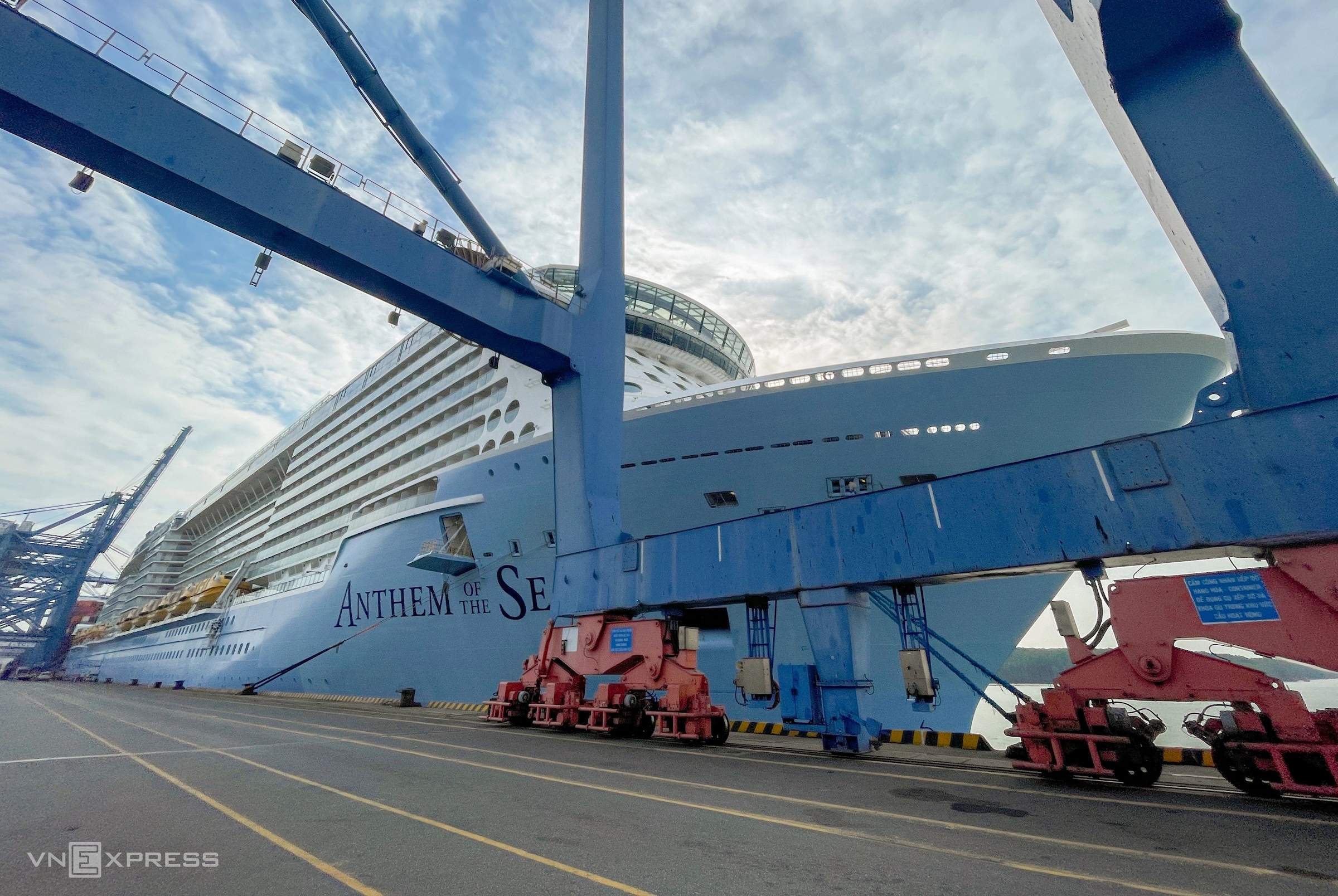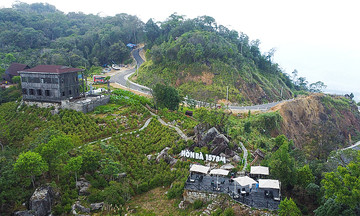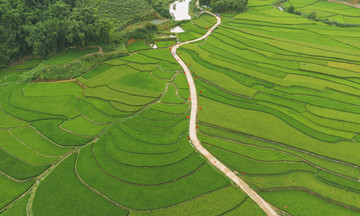"The company is redesigning the website interface and gradually changing the address on all documents," said Nguyen Thi Thuy from the sales department of Kieu Anh Hotel in Vung Tau City, adding that the most noticeable change is the company's new address in Vung Tau ward, Ho Chi Minh City. The merger has not yet significantly affected business operations, and the hotel is still operating normally.
Many companies in Ho Chi Minh City also said the merger did not disrupt business activities but opened up new opportunities. Pham Anh Vu, deputy director of Viet Travel, said the company is currently mainly reviewing and updating old tour programs, adjusting place names, and developing several new regional linkage products. Centralized management helps the tourism industry connect, exploit information, and handle procedures more conveniently.
 |
The headquarters of the Vung Tau ward People's Committee on Ly Thuong Kiet Street with a new sign, 29/6. |
"Previously, to organize a tour, we had to apply for many permits in different localities, such as in Ho Chi Minh City, Binh Duong, and Vung Tau. Now it is more convenient when organizing multi-destination tours," Vu said.
On 1/7, the country officially operated a two-level government model with 34 provinces and cities after the merger. Ho Chi Minh City merged with the entire administrative boundaries of Ba Ria - Vung Tau and Binh Duong.
Nguyen Thi Anh Hoa, director of the Ho Chi Minh City Department of Tourism, stated that the merger of the three localities creates a "megacity of economic and tourism development." The post-merger Ho Chi Minh City has much potential to be exploited immediately. The diversity of tourism resources lies in the fact that Ho Chi Minh City has strengths in urban tourism, MICE, culture and cuisine, and international events; Ba Ria - Vung Tau has islands, high-class resorts, spiritual tourism, casinos, and golf courses; and Binh Duong has industrial tourism, craft villages, and riverside ecotourism.
 |
Yachts anchored at Cai Mep port. Photo: Quynh Tran |
In the initial phase of the merger, the tourism industry will prioritize three tasks: completing the Department of Tourism apparatus, adjusting working regulations, synchronizing data to coordinate activities smoothly, and reviewing and advising on adjustments to related administrative procedures. The Department will coordinate with businesses to build and announce themed products, reposition the city's tourism brand, and promote new destinations and products.
Hoa said that with the completion of phase 1 of Long Thanh International Airport, the travel time from neighboring localities such as Ho Chi Minh City, Vung Tau, and Binh Duong will be shortened to 30-45 minutes. International tourists can go directly to coastal resorts without going through the city center.
The new expressway system, including Ho Chi Minh City - Long Thanh - Dau Giay, Ben Luc - Long Thanh, and Ho Chi Minh City - Thu Dau Mot - Chon Thanh, also enhances connectivity between the Mekong Delta, Ho Chi Minh City, Binh Duong, and the East Sea coastal area.
"The infrastructure advantage will open up opportunities to develop short tours, city breaks, weekend getaways, and exploit tourism models along transportation corridors," Hoa said.
Ho Chi Minh City's tourism industry will coordinate with businesses to build and publicize products based on thematic axes, effectively exploiting the existing tourism strengths of the three localities. The theme "From the city along the river to the sea" connects urban culture, festivals, ecology, and beach resorts; "Holiday road" combines resort travel from the city to rivers and seas; and "Sea culture" connects Can Gio with Vung Tau.
Dr. Justin Matthew Pang, senior program chair of Tourism and Hospitality Management at RMIT University Vietnam, stated that the merger of Ho Chi Minh City, Binh Duong, and Ba Ria - Vung Tau into a unified urban area will significantly reshape the tourism landscape in the region.
The merger will form a multi-center tourism area, creating a destination that blends urban life, industrial and MICE tourism, along with easily accessible coastal resort tourism.
With the population increasing from 9.9 to 13.7 million, the demand for entertainment and tourism activities will also increase. The population boom helps elevate the city's status regionally and globally, attracting investment in infrastructure and accommodation services. Encouraging synchronous regional planning helps the new Ho Chi Minh City diversify tourism experiences. Better transport connections and reasonable planning will make it easier for tourists to travel.
According to Master Ha Quach, lecturer in Tourism and Hospitality Management at RMIT University Vietnam, the biggest benefit of the integration is that it both preserves the tourism characteristics of each locality and enriches the overall picture thanks to diversity and mutually supportive experiences.
Tourism in the new city after the merger can be boosted by sharing resources and reducing the burden on the central area. Air traffic is distributed between Tan Son Nhat Airport and the Long Thanh project, seaports such as Cai Mep - Thi Vai are linked, and the transport network is improved, facilitating convenient regional connections. The uniformity of the tourism workforce also helps ensure consistent service quality.
"This potential can only be realized if the new administrative system is implemented effectively, requiring time, close coordination, and persistent effort," Ha Quach said.
Nguyen Minh Tam, general director of Six Senses Con Dao, has positive expectations for Con Dao tourism after it becomes a special zone of Ho Chi Minh City. When the Con Dao special zone administration or the administrative focal point in Ho Chi Minh City is established, procedures will be handled centrally, professionally, and more quickly.
When the infrastructure is upgraded, traveling to Con Dao will be more convenient, contributing to reducing the still high transportation costs and supporting on-site logistics and supply chains. Regarding human resources, closer connection with Ho Chi Minh City - a center for training and providing quality labor - will help businesses easily recruit skilled professionals in fields such as therapy, cuisine, and services.
In terms of market expansion, the integration of Con Dao into Ho Chi Minh City's general promotion programs will help the island's image be more widely introduced. International tourists will have more destination choices combining relaxation, work, and contact with nature.
"Thanks to its ecosystem, primeval forests, beaches, and sea turtle conservation programs, Con Dao can attract investors interested in resort models combined with meetings and environmental protection, working and relaxing in the National Park space," Minh Tam said.
 |
A secluded mountainside and beachfront resort in Con Dao. Photo: Six Senses Con Dao |
Dr. Justin Matthew Pang believes there will be many challenges after the merger. "One of the urgent challenges in developing tourism in a multi-center urban area like the new Ho Chi Minh City is the lack of unified planning and coordination between previously separate administrative units," he said.
Each tourism department of Ho Chi Minh City, Binh Duong, and Ba Ria - Vung Tau had its own strategies, priorities, and brands before the merger. Without careful assessment and clear coordination mechanisms, the urban area could become a "hot pot" with conflicting objectives, overlapping investments, inconsistent messages, and wasted resources.
This is similar to the situation that occurred in the Greater Bay Area of China, which experienced instability in its early stages of development due to a lack of coordination. If a common governance framework, inter-regional marketing strategy, and regional tourism planning are not established, the diverse strength of the merger can become a disadvantage, causing confusion and reducing global competitiveness.
"Ho Chi Minh City can learn from major global cities like the Tokyo Metropolitan Area," Dr. Justin Matthew Pang said, adding that Tokyo's secret to success lies in integrated planning, public transport-oriented development, and satellite cities supporting diverse tourism experiences. Instead of competing, they clearly define the tourism roles of each locality, achieving diversity without fragmentation. This city has demonstrated effectiveness through the construction of multi-destination tourism packages, synchronized infrastructure and marketing strategies, and effective management coordination.
According to Dr. Justin Matthew, the expanded Ho Chi Minh City should develop according to a multi-center tourism model, with a common coordinating body or an intergovernmental tourism council for unified management.
"It is important that the regions do not compete with each other but divide their supporting roles, with each region promoting its own strengths to complete the overall tourism picture," Justin Matthew concluded.
Bich Phuong












